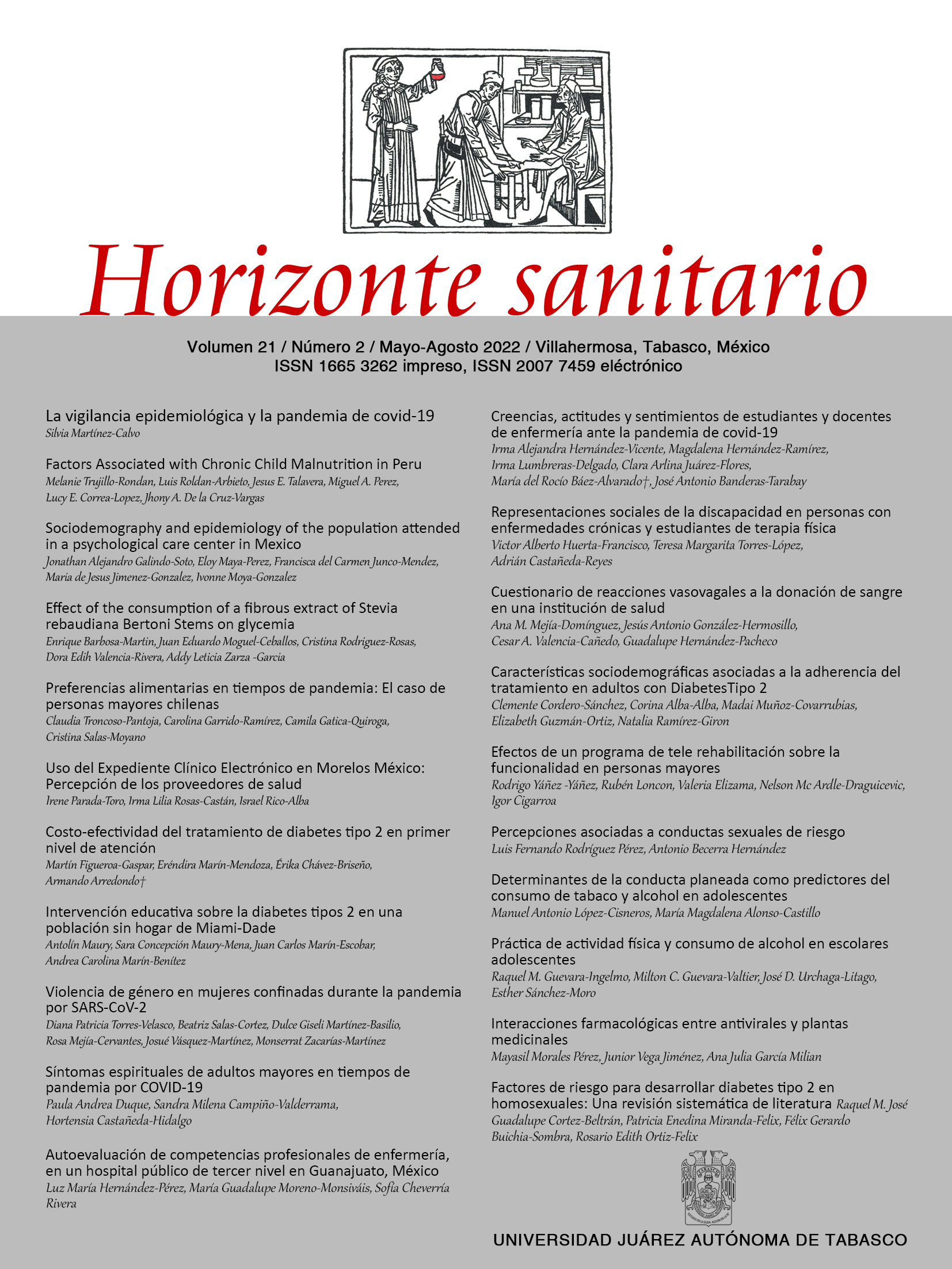Sociodemographical characteristics associated with adherence to treatment in adults with type 2 Diabetes
DOI:
https://doi.org/10.19136/hs.a21n2.3885Abstract
Objective: To establish the association of sociodemographic characteristics and treatment adherence in Mexican adults with Type 2 Diabetes.
Materials and Methods: A descriptive, cross-sectional study was made in Mexican adults over 18 years with Type 2 Diabetes who attended a diabetes clinic of a public hospital. The sample were 100 adults. Conscious adults, diagnosed with DT2, with a minimum evolution of three years with the diagnostic were included. The Morisky, Green and Levine´s test was used to identify the adherence to the treatment.
Results: The female sex predominated (62%), the adults between 50-59 years were the most representative group (59%); el 46% had primary school and 69% were married. The 23% of the sample has 3 years with the diagnostic, only 38% of the respondents do exercise 10-15 minutes a day and 28% did not do exercise; the majority report having a pharmacological treatment based on oral hypoglycemic agents (82%). The age was associate with the adherence to the treatment (p<.005).
Conclusions: Age was the only sociodemographic characteristic that was significantly associated with adherence to treatment in Mexican adults with Type 2 Diabetes. Health personnel, mainly those at the first level of care, should focus on promoting adherence to treatment in patients suffering from DT2, taking into account their sociodemographic characteristics, especially age.
Key words: Treatment adherence and compliance; Type 2 diabetes; Community health nursing.
Downloads
References
International Diabetes Federation. Atlas de la Diabetes de la FID [Libro en Internet]. 9ª Edición. Bélgica: Federación Internacional de Diabetes; 2019 [acceso 20 de enero de 2020]. Disponible en: https://diabetesatlas.org/upload/resources/material/20200302_133352_2406-IDF-ATLAS-SPAN-BOOK.pdf
Federación Mexicana de Diabetes. Principales causas de mortalidad en México [Internet]. México: Federación Mexicana de Diabetes; 2016 [acceso 26 de enero de 2020]. Disponible en: http://fmdiabetes.org/principales-causas-mortalidad-mexico-2/
Instituto Nacional de Salud Pública. Encuesta Nacional de Salud y Nutrición 2018 [Libro en Internet]. México: Instituto Nacional de Salud Pública; 2018 [acceso 28 de enero de 2020]. Disponible en:https://ensanut.insp.mx/encuestas/ensanut2018/doctos/informes/ensanut_2018_presentacion_resultados.pdf
Instituto Nacional de Estadística y Geografía. Comunicado de Prensa Número 525/18 [Internet]. México: Instituto Nacional de Estadística y Geografía; 2018 [acceso 30 de enero de 2020]. Disponible en: https://www.inegi.org.mx/contenidos/saladeprensa/boletines/2018/EstSociodemo/DEFUNCIONES2017.pdf
Sen S, Chakraborty R, De B. Biomarkers of Diabetes and Diabetic Complications. Diabetes Mellitus in 21st Century [Internet] 2018 [acceso 31 de enero de 2020]; 101-124. Disponible en: https://link.springer.com/chapter/10.1007/978-981-10-1542-7_9
Organización Mundial de la Salud. Informe Mundial sobre la Diabetes [Internet]. 1ª Edición. Ginebra: Organización Mundial de la Salud; 2016 [acceso 15 mayo 2020]. Disponible en: https://apps.who.int/iris/bitstream/handle/10665/254649/9789243565255-spa.pdf;jsessionid=94CD2BB14520E604B593BB212176A347?sequence=1
Centro Nacional de Programas Preventivos y Control de Enfermedades. Estrategia Nacional Para la Prevención y el Control del Sobrepeso, la Obesidad y la Diabetes. Diabetes [Internet]. 1ª Edición. México: Secretaría de Salud; 2013 [acceso 17 mayo 2020]. Disponible en: http://www.cenaprece.salud.gob.mx/descargas/pdf/EstrategiaNacionalSobrepeso.pdf
Villa KF, González CG, Rodríguez MP, Peña EB, Ríos CAG, Maygua MAV. Dimensiones de calidad de vida afectadas en pacientes diabéticos. Rev Cubana Enferm [Internet] 2020 [acceso 27 mayo 2020]; 36(1). Disponible en: http://www.revenfermeria.sld.cu/index.php/enf/article/view/2610
Organización Mundial de la Salud. Adherencia a los tratamientos a largo plazo, pruebas para la acción [Internet]. 1ª Edición. Ginebra: Organización Mundial de la Salud; 2004 [acceso 15 abril 2020]. Disponible en: https://www.paho.org/hq/dmdocuments/2012/WHO-Adherence-Long-Term-Therapies-Spa-2003.pdf
Polonsky WH, Henry RR. Poor medication adherence in type 2 diabetes: recognizing the scope of the problem and its key contributors. Patient prefer adherence [Internet] 2016 [acceso 28 mayo 2020]; 10(1), 1299. Disponible en: https://www.ncbi.nlm.nih.gov/pmc/articles/PMC4966497/
Aloudah NM, Scott NW, Aljadhey HS, Araujo-Soares V, Alrubeaan KA, Watson MC. Medication adherence among patients with Type 2 diabetes: A mixed methods study. PloS one [Internet] 2018 [acceso 15 mayo 2020]; 13(12), e0207583. Disponible en: https://journals.plos.org/plosone/article?id=10.1371/journal.pone.0207583
Noriega AA, Jiménez RC, Monterroza DM. Apoyo social y control metabólico en la diabetes mellitus tipo 2. Revista cuidarte [Internet] 2017 [acceso 25 mayo 2020]; 8(2), 1668-76. Disponible en: https://www.redalyc.org/pdf/3595/359550872011.pdf
Bello Escamilla NV, Montoya Cáceres PA. Adherencia al tratamiento farmacológico en adultos mayores diabéticos tipo 2 y sus factores asociados. Gerokomos [Internet]. 2017 [acceso junio 25 2020]; 28(2): 73-77. Disponible en: http://scielo.isciii.es/scielo.php?script=sci_arttext&pid=S1134-928X2017000200073&lng=es
Mendizábal T, Navarro N, Ramírez A, Cervera M, Estrada E, Ruiz I. Características sociodemográficas y clínicas de pacientes con diabetes tipo 2 y microangiopatías. An. Fac. med [Internet]. 2010 [acceso 2020 Jun 24]; 71(1): 7-12. Disponible en: http://www.scielo.org.pe/scielo.php?script=sci_arttext&pid=S1025-55832010000100002&lng=es
Rincón-Romero MK, Torres-Contreras C, Corredor-Pardo KA. Adherencia terapéutica en personas con diabetes mellitus tipo 2. Revista ciencia y cuidado [Internet] 2017 [acceso 2020 Jun 24]; 14(1), 40-59. Disponible en: https://revistas.ufps.edu.co/index.php/cienciaycuidado/article/view/806
Secretaría de Gobernación. NORMA Oficial Mexicana NOM-012-SSA3-2012, Que establece los criterios para la ejecución de proyectos de investigación para la salud en seres humanos [Internet]. México: Diario Oficial de la Federación, 2012 [acceso 2020 Jun 24]. Disponible en: http://dof.gob.mx/nota_detalle.php?codigo=5284148&fecha=04/01/2013
Morisky, DE, Green LW, Levine DM. Concurrent and predictive validity of a self-reported measure of medication adherence. Medical care [Internet] 1986 [acceso 2020 Jun 24]; 67-74. Disponible en: https://www.jstor.org/stable/3764638?casa_token=uz54zU9hbUYAAAAA:wvoc9-gIEA_mpobGiFLC16zN2LGRYvuS1tnm1VB_HwcAdqV5aHngOlTgokKqfNUSEHSAv61h5QQ6ldhxBbwZ9pdaUETj_-9ZvRQybpPfd8YKyMGEEvPxkQ
Morisky, DE, Ang A, Krousel‐Wood M, Ward HJ. Predictive validity of a medication adherence measure in an outpatient setting. Journal Clin Hypertens [Internet] 2008 [acceso 2020 Jun 24]; 10(5), 348-354. Disponible en: https://onlinelibrary.wiley.com/doi/full/10.1111/j.1751-7176.2008.07572.x
Hosseini-Marznaki Z, Tabari-Khomeiran R, Taheri-Ezbarami Z, Kazemnejad E. Adherence to treatment and its predictive factors among adults with type 2 diabetes in northern Iran. Med J Nutrition Metab [Internet] 2019 [acceso 2020 Jun 24]; 12(1), 45-59. Disponible en: https://content.iospress.com/articles/mediterranean-journal-of-nutrition-and-metabolism/mnm180241
Yeh JZ, Wei CJ, Weng SF, Tsai CY, Shih JH, Shih CL, Chiu CH. Disease-specific health literacy, disease knowledge, and adherence behavior among patients with type 2 diabetes in Taiwan. BMC Public Health [Internet] 2018 [acceso 2020 Jun 24]; 18(1):1062. Disponible en: https://link.springer.com/article/10.1186/s12889-018-5972-x
Shams N, Amjad S, Ahmed W, Saleem F. Drug non-adherence in type 2 diabetes mellitus; predictors and associations. J Ayub Med Coll Abbottabad [Internet] 2016 [acceso 2020 Jun 24]; 28(2), 302-307. Disponible en: http://www.ayubmed.edu.pk/jamc/index.php/jamc/article/view/394
García de Alba-García JE, Salcedo-Rocha AL, Hayes Bautista D, Milke Najar ME, Dominio cultural sobre causas de diabetes en tres generaciones de estratos populares en Guadalajara, México. Revista Médica del Instituto Mexicano del Seguro Social [Internet]. 2015 [acceso 2020 Jun 24];53(3):308-315. Disponible en: https://www.redalyc.org/articulo.oa?id=457744937012
Published
Issue
Section
License
Copyright (c) 2021 HORIZONTE SANITARIO

This work is licensed under a Creative Commons Attribution-NonCommercial-ShareAlike 4.0 International License.


































